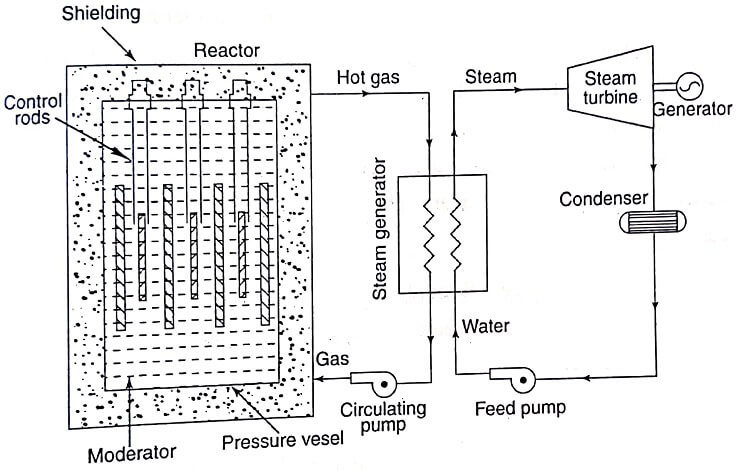Like other helium gas cooled reactor which have operated or are under development, these will be high temperature units of 850°C, suitable for power generation, thermochemical hydrogen production or other process heat. For electricity, the gas will directly drive a gas turbine. (Brayton cycle) and steam turbine cycle. Fuels would include depleted Uranium and any other fissile or fertile materials. Spent fuel would be reprocessed on site and all the actinides are recycled to minimise production of long lived radioactive wastes.
In this reactor, carbon dioxide gas is used to carry away the heat produced due to nuclear fission in the reactor. The first gas cooled reactor with CO2 gas as coolant and graphite as moderator were developed in Britain during 1956-69. The fuel was natural Uranium, clad with an alloy of magnesium called Magnox. The gas is maintained at a pressure of about 16bar.
Various types of GCR have been developed. England developing an advanced gas cooled reactor (AGR system) and Germany and the USA developing helium cooled, graphite moderated systems. Gas enters the reactor at the bottom. This gas is heated by the heat released due to the fission of fuel and leaves the reactor at the top and flows to heat exchanger. In the heat exchanger, hot gas transfers its heat to water which gets converted into steam. The gas is recirculated with the help of gas blowers.
This steam passes through the turbine and expanded to get mechanical work. Exhaust steam from the turbine is condensed with the help of condenser.
Advantages for GCR
- Fuel processing is simpler than any other reactors.
- Corrosion by coolant is negligible.
- Coolant doesn’t react with fuel or with other core materials.
- Coolant will not flash into vapor if primary system is ruptured.
- Coolant has very low capture cross section.
- The Uranium carbide and graphite are able to resist high temperatures and hence, the problem of limiting the fuel element temperature is not as series as in other reactors.
- System can be designated with negative temperature coefficient.
- It gives better neutron economy due to low parasite absorption.
- Any fuel can be used, including natural Uranium.
- Graphic remains stable under irradiation at high temperatures.
- Coolant is cheap.
- Ordinary leakage can be tolerated.
- There is no possibility of explosion in reactor since, the use of CO2 as coolant completely eliminates this problem.
- Gas turbine may be employed.
Disadvantages for GCR
- Fuel loading is more elaborated and costly.
- The cost of heavy water (D2O) is high (Rs. 500 per kg).
- Power density is very low (9.7kW/litre) and hence, large vessel is required.
- Large amount of fuel loading is initially required since, the critical mass is high.
- Very high standard design, manufacture inspection and maintenance are required.
- Leakage of gas is a major problem, if helium is used instead of CO2.
- More power is required for the circulation of coolant when compared to water-cooled reactors.
- Reactor vessel and heat exchangers large and expensive.
- Heat transfer efficiency is low.
- Coolant must be pressurized.
- Carbon dioxide dissociates above 300 Centigrade.
| Read More Topics |
| Fast Breeder Reactor (FBR) |
| Pressurised Water Reactor (PWR) |
| Boiling Water Reactor (BWR) |






